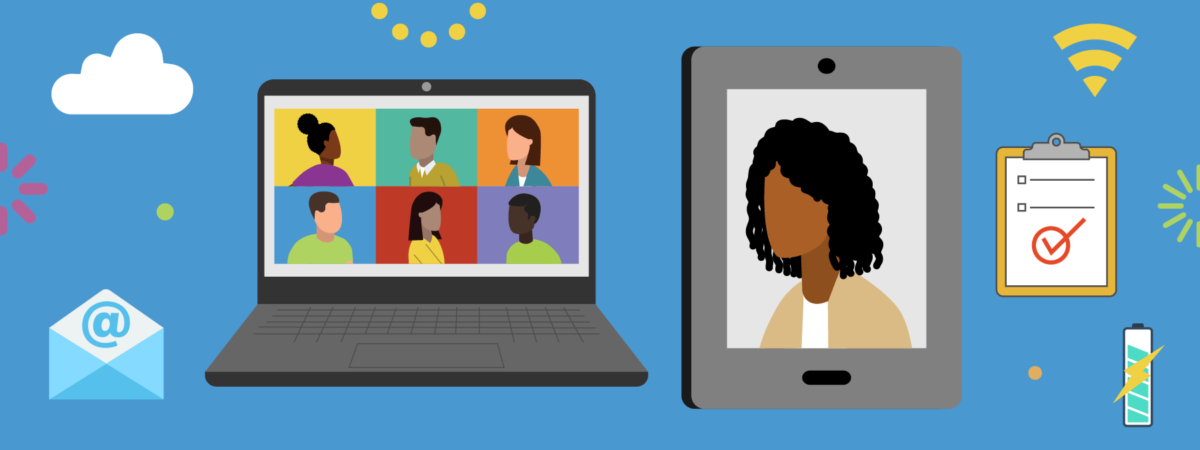
February 22, 2021 | By Jessica Schuler and Lydia Logan
Since 2014, the Verizon Innovative Learning Schools (VILS) initiative has provided every student and teacher at select middle and high schools with a device equipped with a data plan to support learning in and out of the classroom. The program, which grew to 264 schools in the fall, also provides extensive professional development to teachers that supports powerful teaching and learning.
“We have realized that the adoption of VILS three years ago laid the foundation for our successes so far this year,” said Jonathan Lubas, Verizon Innovative Learning coach at Breakthrough Schools in Cleveland, Ohio.
Results of a recent survey of educators at participating schools conducted by our partner Westat agreed with Lubas’ sentiment, showing that prior experience integrating technology into learning made the shift to distance learning smoother. In fact, more than 70 percent of teachers in Verizon Innovative Learning Schools reported feeling prepared, with 93 percent crediting the program with making aspects of remote instruction easier to implement.
“[Students] having that iPad one-to-one and knowing how to use the apps that we had trained them on before we left definitely made it a lot easier for us because we just tell them, ‘Go to this app and do this assignment,’ and they were just able to do it without a lot of questions,” said a teacher from Cohort 4, which is in its fourth year in the program. “The students already were used to using those platforms in the classroom.”
But even more than having familiarity with the technology, educators in these schools overwhelmingly agreed that the professional learning opportunities provided by the initiative helped prepare them for their new learning environment. Every Verizon Innovative Learning School is assigned a full-time instructional technology coach to support teachers with effectively integrating technology into learning. In addition, Verizon Innovative Learning Schools educators participate in workshops about blended learning and digital collaboration throughout the school year, strategies that became even more valuable when school buildings closed and instruction moved online.
“Back in March when we were thrust into a fully virtual model…our students and teachers were at an advantage,” said Phillip Izlar, the Verizon Innovative Learning coach at Friendship Chamberlain Middle School in Washington, D.C. “Our students already had the devices and data to continue their education, but more importantly, [they had] the experience of being in a flipped classroom and using online tools. Our teachers had already participated in professional development on how to incorporate the blended learning model into their classrooms. They were fortunate enough to have extensive knowledge about the resources that were available to make online learning and teaching possible, meaningful, and engaging.”
Educators within the Verizon Innovative Learning Schools community have the benefit of a network of educators both within their own districts and across the country with whom they can collaborate and seek support with distance learning challenges. For example, the Verizon Innovative Learning coach at Ruben Dario Middle School in Miami, Florida, crowdsourced content from other VILS coaches in the district for a teacher online learning repository containing best instructional practices, tech tool tutorials, and more.
“From the beginning, I connected with the coaches in my district and we [worked in PLCs] together very frequently,” shared Cortney Chao, the Verizon Innovative Learning coach at Argyle Magnet Middle School in Silver Spring, Maryland. “We can video conference, we can share resources, we can share our successes.”
This forced pivot to fully remote learning and the necessary flexibility to go from in-person to at-home to a hybrid model has shown us that all teachers need to have the training to teach in all three learning environments. We also have learned that every student needs a working device with internet access, and that schools need to rethink the provision of one-to-one devices so students can continue to have equitable learning experiences regardless of the setting.
We are now having conversations about closing new learning gaps that have formed as a result of the pandemic, which have compounded pre-existing gaps for traditionally marginalized learners—especially Black and Brown kids and those from low-income homes. Our Verizon Innovative Learning Schools have shown that having the fundamental tools required to handle the shift—technology, access, teacher coaching and training, IT support, and students familiar with using devices for learning—put them in a better position to help their students, as well as their peers in their district, to keep learning going.
In December 2020, Congress appropriated $3.2 billion to the FCC for the creation of the Emergency Broadband Benefit Program (EBBP) so that eligible low-income households may receive a discount off the cost of broadband service and certain connected devices during an emergency period relating to the COVID-19 pandemic. While the EBBP is a step in the right direction to close access gaps, our nation needs to make a commitment to equity and re-prioritizing the systems and resources available, so that teachers, students, and families have the tools they need. We don’t need to wait to see what the “new normal” will look like for school in the fall; this should be the new normal.
Learn more about the Verizon Innovative Learning Schools program and apply to become a Verizon Innovative Learning School by March 12.
By Elliott Barnes and Sara Mungall